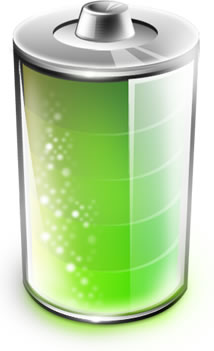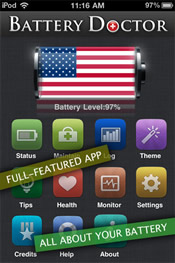Smartphone battery life explained:
As many will know my Samsung S2 battery life article has become quite the flag bearer for mobile inquirer, unfortunately it has taken me a while to get around to writing the follow-up that aims to help owners of smartphones with their battery life issues…instead of just moaning..;)
So here it is, the definitive guide and resource to learning more about your smartphone battery and improving its life:

I am going to cover myths of battery life on smartphones, and ways you can help prolong the battery life of your device in general:
Firstly I have to tell you what battery we are talking about when it comes to the power source that is actually inside your smartphone:
Li-ion smartphone battery:
Your smartphone invariably makes use of a rather amazing bit of kit called a Lithium-ion type battery, with my Samsung S2 taking a Li-ion 1850mAh Rogers Model with a 1650mAh model also being offered for this device.
Your smartphone probably uses something similar.
The problem that many are facing, is that the power demanded from your smartphone is not yet matched by the power offered from your battery, and this causes obvious issues, not least of which in Apple’s case is you can not actually replace the battery, so if it runs out during your day, which they so often do, you pretty much have no choice but to stop and recharge.
And so it has to be said that at least in devices where you can replace the battery, you can currently own two or more spares, to get you through a little longer.
The smartphone battery test:
This test was carried out in 2010 by batteryuniversity.com and is a thorough analysis of how a pool of batteries degrades over time under certain conditions.
The pool of brand new 1500mA Li-ion batteries for smartphones were tested on a Cadex C7400 battery analyzer. These 11 pouch packs, started with a capacity range of 88–94 percent, they then decreased in capacity to around 73–84 percent after 250 full discharge cycles (2010).
Here are some of the key findings from the fairly technical report:
It has to be said that they were seemingly testing for the life of the battery and it is slightly configuring as to if they refer to the life of a charge or the life of the battery over months…i.e how much it degrades over time, either way some truths are still contained that we should all really know about.
Similar to a mechanical device that wears out faster with heavy use, so also does the depth of discharge (DoD) determine the cycle count. The smaller the depth of discharge, the longer the battery will last. If at all possible, avoid frequent full discharges and charge more often between uses.
This above quote dispels most commonly held views that you should let your smartphone battery fully charge down when you first get your phone, and then charge it all the way back up, and keep doing this through the lifetime of your phones battery.
Myth number 1 – Memory effect:
“Memory effect” caused some rechargeable batteries to lose maximum charge capacity unless they were fully drained before recharging, this effect does not occur with smartphone batteries and the chart below shows that for optimum life of a smartphone battery, they are best kept charged and not allowed to drop to fully empty that often.
Here is a chart showing that if you were able to keep your phone charged at around 40% all the time instead of going from full to empty as many owners do, your overall battery capacity would not degrade at such a level.

Myth number 2 – Priming batteries:
This was also necessary for some (ones that did not have it done at the factory) Nickel Cadmium (NiCd) and Nickel Metal Hydrate (NiMH) batteries which needed to be “primed” in order to ensure that the worked to their fullest, this meant that you needed to initially run the battery dead before charging it up.
Li-ion in general (including Li-ion Polymers) do not need priming.
Myth number 3 – Temperature:
Gone are the days of putting your battery in the fridge or in the the sun to get a little more juice out of your smartphone, and is totally impractical anyway.
Your smartphone battery will nowadays most likely prefer to be kept at around 20 degrees Celsius, this means that recharging using a wireless mat for instance will not probably help the battery stay in its prime condition as the energy lost in the exchange is transferred into heat and will actually cause the battery to unnecessarily raise in temperature overall, and looking at “scientific” data, this would lead me to conclude that a degradation would occur which may not have happened if you used a conventional lead based method.
Exposing the battery to high temperature and being at full state-of-charge for an extended time can be more damaging than cycling. Newer designs may show improved results.
Apps to help battery life:
Well one way maybe to actually kill your apps in all honesty, using your task killer options where available, however there are rumours to be some application options that may help to improve your battery life.
For the iPhone you have:

And for Android you have:

I have no idea whatsoever if these work well or not, I have trialled the free version of Juice Defender to improve my own Samsung S2 battery problems but I found it to be quite complicated and unsure it did anything much after trialling for a few days on various settings, but maybe the pro version is better.
Accessories to help smartphone battery life:
We covered this model in our top 5 iPad accessories list, so here it is again.
The New Trent iCruiser IMP1000 11000mAh External Battery Pack, which will give you a charger on the go.
This nifty device is really worth checking out especially if you like camping etc.
Methods you can utilise day to day to extend battery life:
There are some every day lessons to be practised that many people may not know about and should help you obtain better battery life in general and will work for most smartphones.
[arrowlist]
- Keep your background image simple
- Underclock your phone’s CPU
- Disable GPS / Bluetooth
- Force a 2G or 3G signal do not make your device keep switching
- Reduce widgets on your home screen
- Minimize auto sync features
- Reduce screen brightness
[/arrowlist]
*In all honesty some of the above areas that I mentioned could do with fleshing out a bit, as some points are not that obvious to accomplish for the average user.
Innovations that could be considered to save battery life:
Here I want to take a look at some areas that could be developed that would help bring about battery life improvements:
Cloud based technology for content delivery:
More and more cloud based applications like Onlive are now taking some of the heat off our smartphones processors, by doing the calculations in the cloud and sending a compressed stream to decode on our phones, this method allows extremely high quality gaming to be seen on smartphones and mobile devices, I think that GPS would benefit from improvements here.
Hot Swapping:
One inventor called Ric Richardson’s has produced, what he calls, “hotswap” batteries for laptops, these new batteries allow you to take one battery out and replace them with another without having to turn the device off and create a 2-5 minute delay, this would be very useful for people who need to keep on a conversation after a particularly heavy day using their battery…emergencies also.
Wi-Fi Scaling:
Have you heard of Wi-Fi Scaling?. The new concept that could save 50% of your battery while it is idle.
Mr Kang Shin and Zinyhu Zin Yang at The University of Michigan have been testing ways to reduce the time your smartphone battery wastes listening for signals.
E-Mili, stands for “Energy-Minimizing Idle Listening”, and is designed to reduce the power needed to provide that listening functionality that smartphones rely on.
Exciting as this technology is, it is also seemingly in its early stages though so they are currently..
“….pursuing patent protection for the intellectual property, and is seeking commercialization partners to help bring the technology to market.”
So there you have quite a few areas that could start to seep into every day use and provide our smartphones with a little #MoreJuice!
Your comments:
We would love to hear your thoughts on the applications mentioned, and indeed any battery saving tips that you use, or areas that we may have omitted that could be interesting topics of conversation for our readers.
Anthony Munns